Exploring Social Water Research: Quantitative Network Analysis as Assistance for Qualitative Social Research
Abstract
1. Introduction
2. Materials and Methods
2.1. Methodology
2.2. Data Collection
2.3. Quantitative Network Analysis
2.4. Qualitative Interpretation of Clusters
3. Results
3.1. Descriptive
3.2. Identification of Thematic Clusters
3.3. Interpretation of Thematic Clusters over Time
4. Discussion
5. Conclusions
Author Contributions
Funding
Data Availability Statement
Acknowledgments
Conflicts of Interest
Appendix A
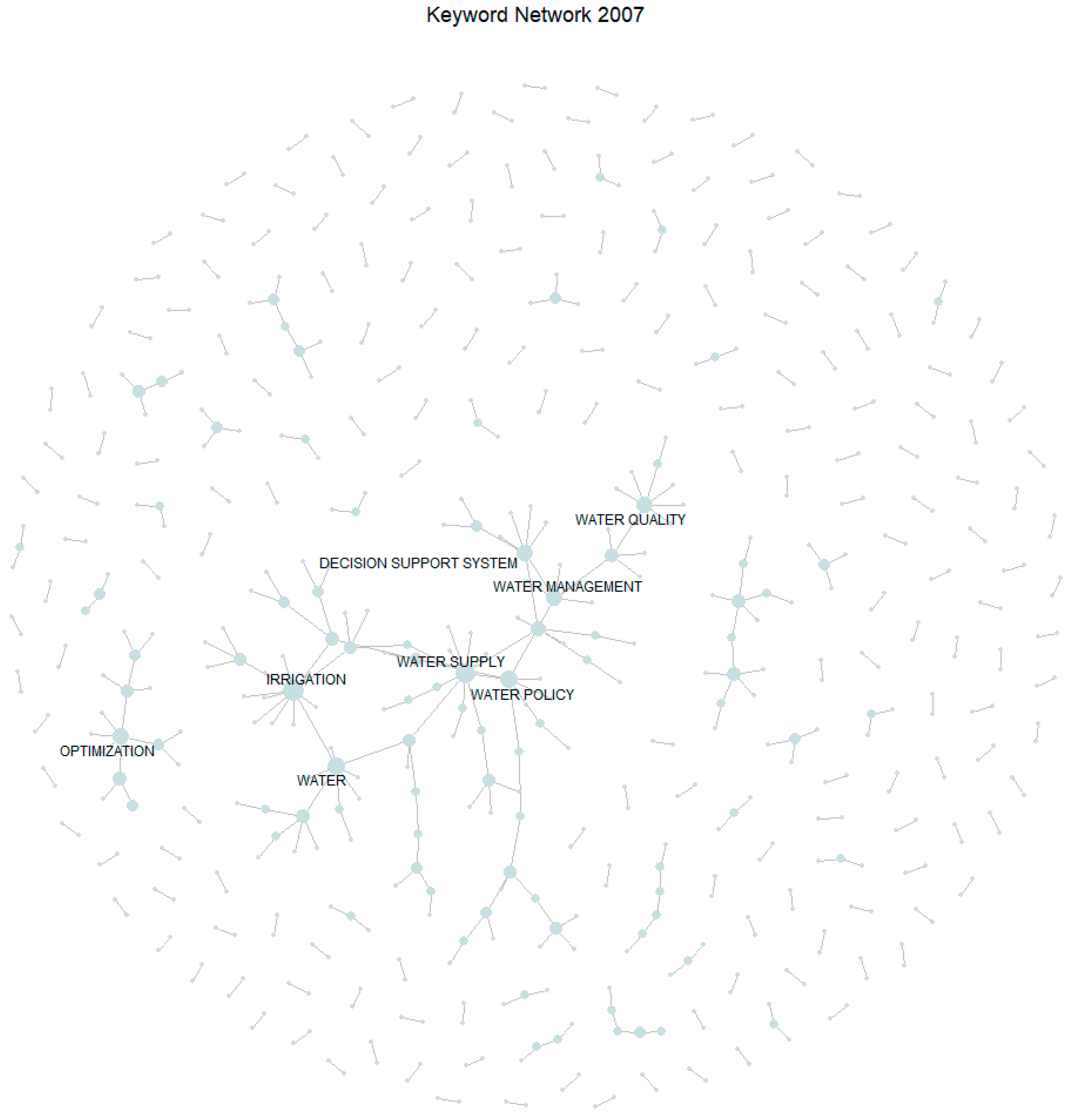
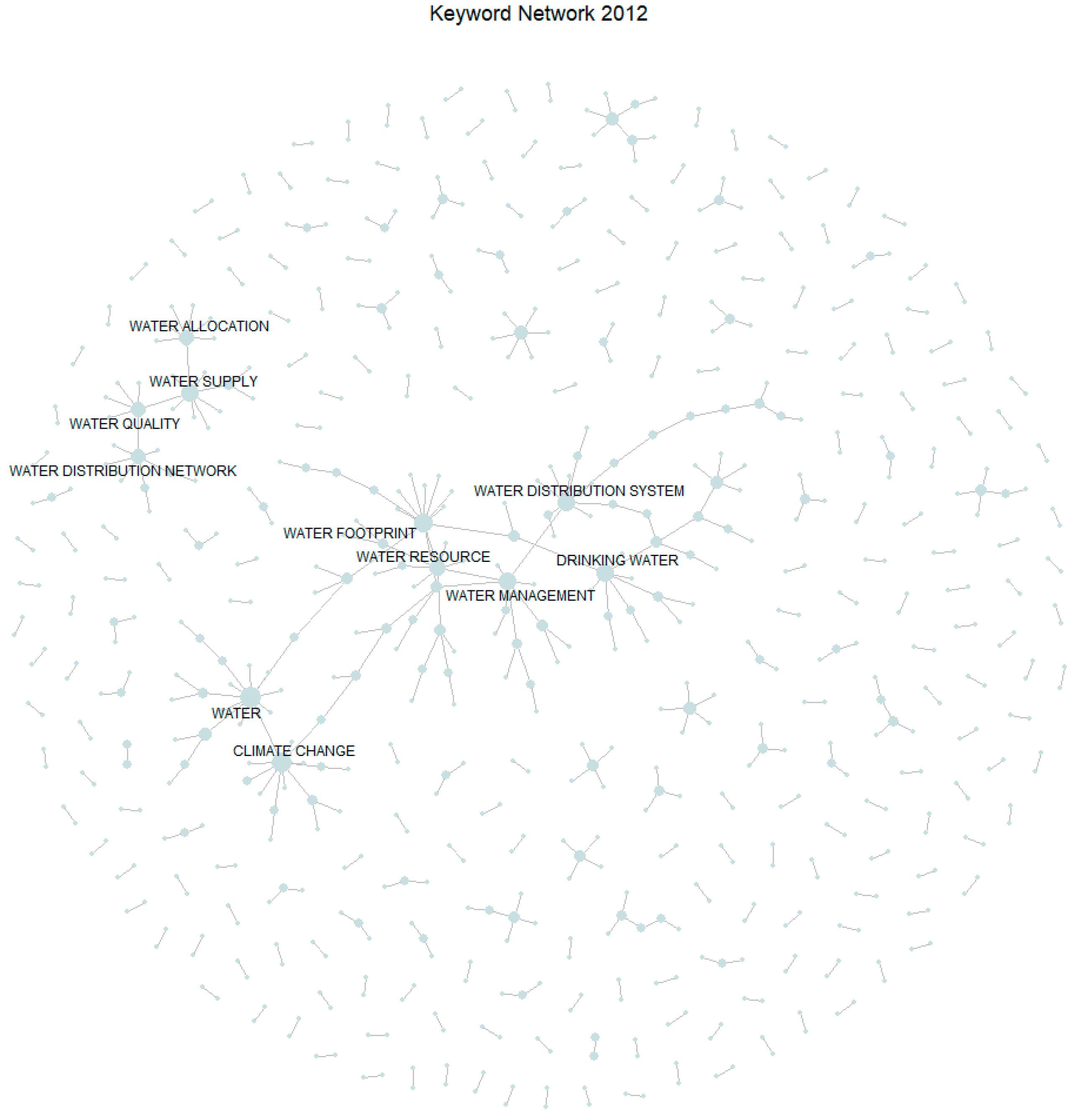
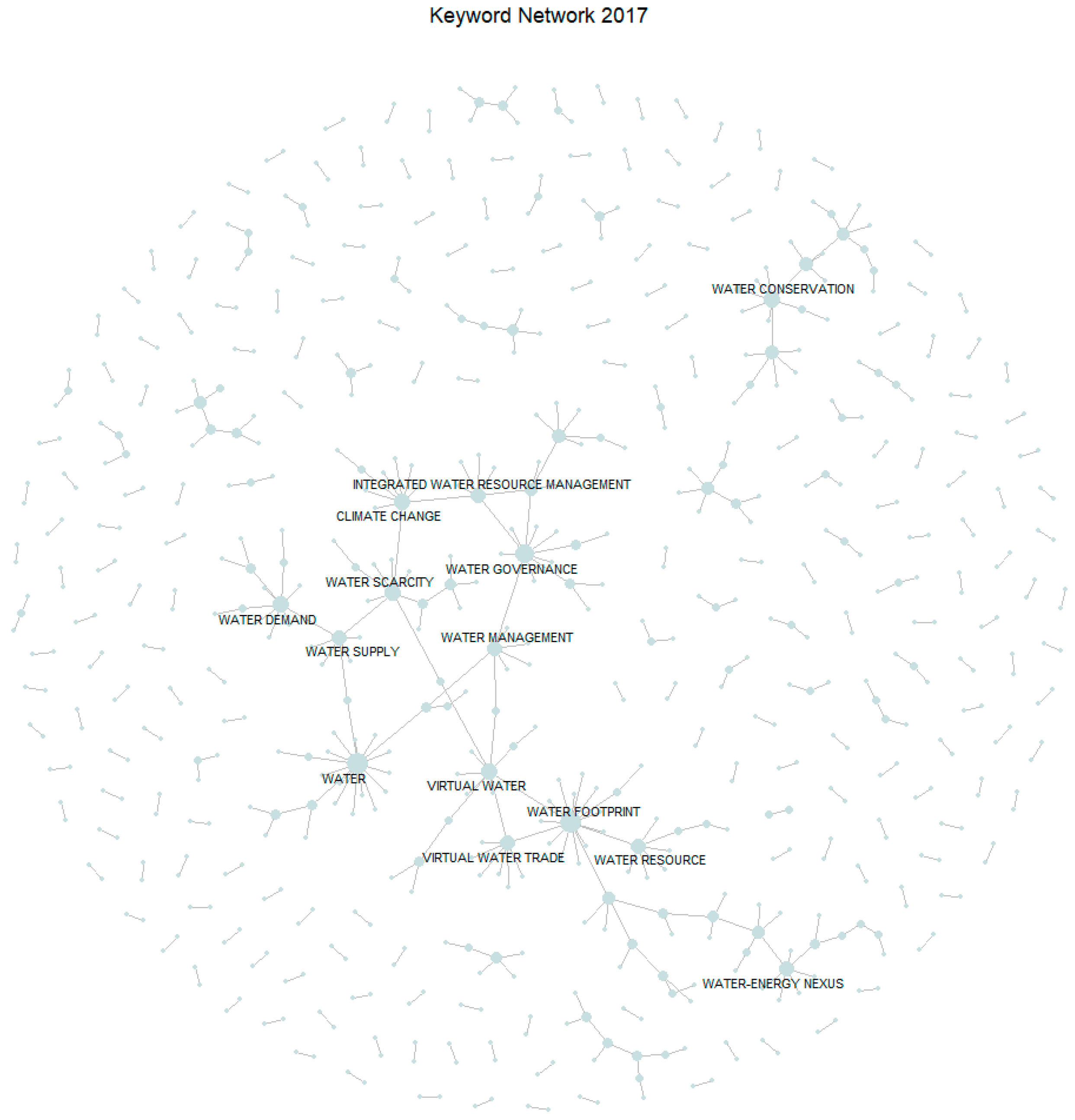
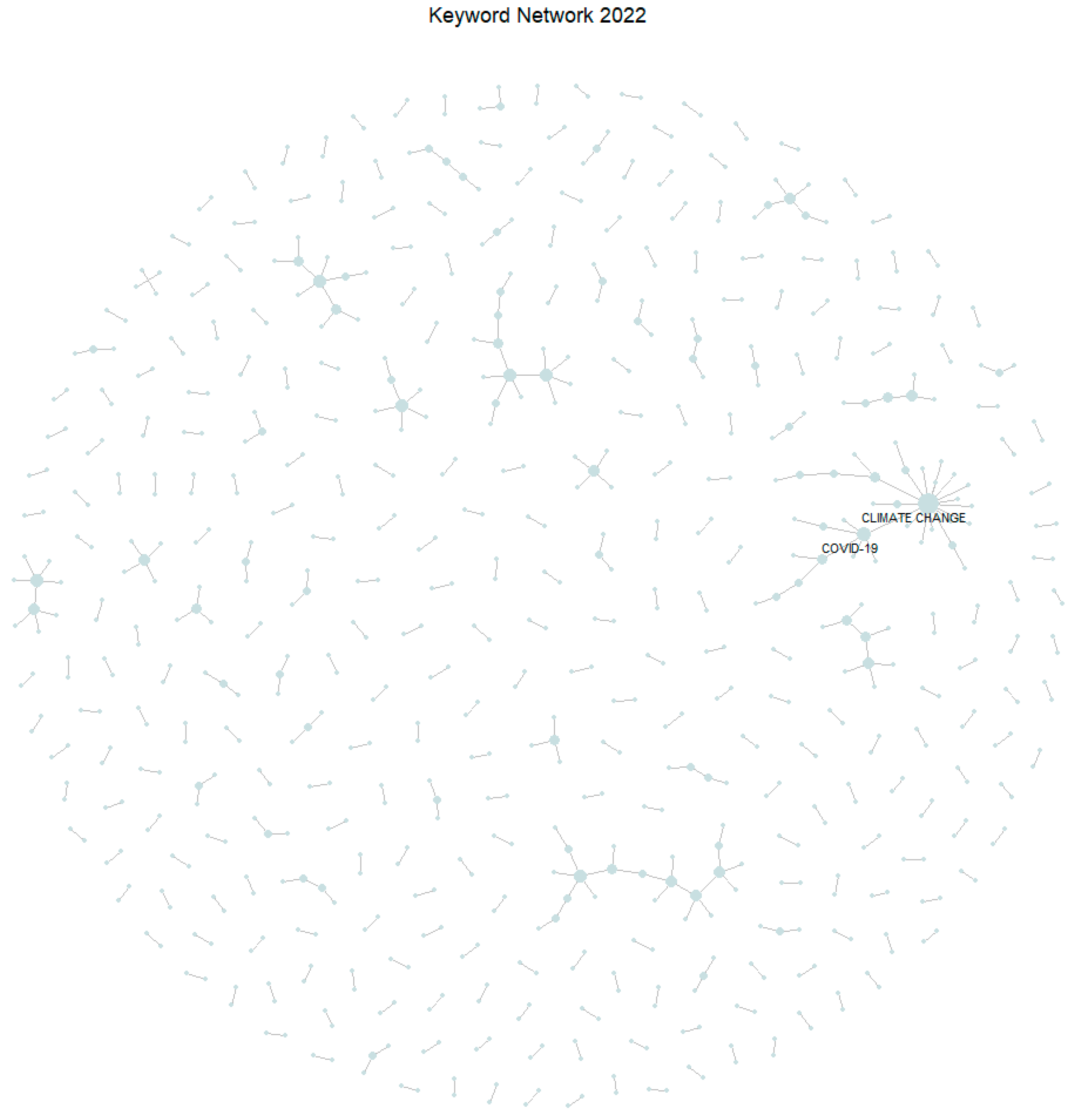


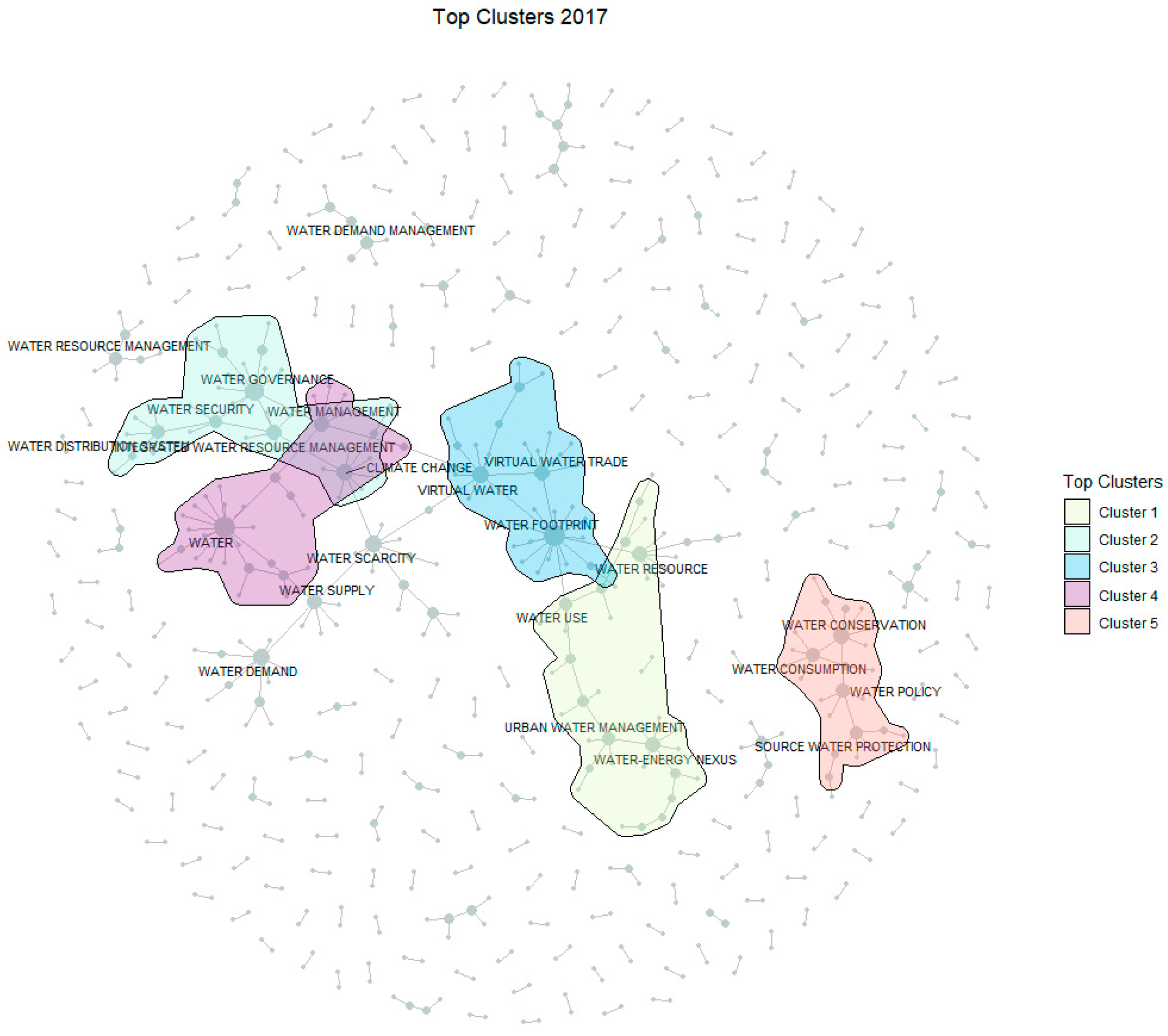

| 2007 | Keywords | Qualification |
| Cluster 1 | Water Economics, Water, Water Shortage, Markets For Temporary Water Transfers, Globalisation, Irrigation, Data Envelopment Analysis (Dea), Pavement, Drought Risk, Urban, Residential Location, Water Framework Directive, Hydrogen Economy, Informal Water Development, Access, Water Right, Public-Private Partnerships, Public Participation, Participation, Environmental Impact, Regression Analysis, Crops, User Organizations, Central Asia, Adoption, Understandings, Potable Water, Institutional Design, Stakeholder Organisations, Foreign Investment Dependence, Social Capital, Common Agricultural Policy | Water Supply and Management: Focuses on various aspects of water supply and management, including water demand, mathematical modeling, and information, as well as economic and institutional dynamics within the water sector. |
| Cluster 2 | Water Supply, Management, Water Demand, Hydraulic Structures, Climatic Change, Mathematical Modelling, Developing Countries, Water Conservation, Block Tariffs, Information Technology, Wsm- Dss Tool, Optimization Models, Corrosion, Water Resource, Customer, Privatization, Planning & Scheduling, Price Elasticity, Risk Assessment, Measurement, Sustainable Utilization, Shadow Price, Uniformity | Water Economics and Globalization: Emphasizes water economics, markets for temporary water transfers, and globalization |
| Cluster 3 | Water Quality, Water Management, Participatory Irrigation Management, Bioretention, Multivariate Modeling And Prediction, Dss, Modeling, Non-Equilibrium, Heavy Metals, Ecology, Drainage, Dissolved Oxygen, Great Usuthu River, Gender, S1d_Dual, Netherlands, Action Plan | Water Quality and Management: Addresses water quality, development policy, participatory irrigation management, and ecological aspects |
| Cluster 4 | Virtual Water In Libya, Optimization, Construction Costs, Water Distribution System, Water Security, Computation, Deterioration, Artificial Neural Network, Genetic Algorithm, Hot Water Networks, Economic Factors, Self Purification, Damage, Cross-Entropy, Pumps, Participatory Governance, Hydraulic Networks | Water Market and Policy: Focuses on water market, water transfer, water pricing, water shortages, and transboundary river management |
| Cluster 5 | Water Market, Water Transfer, Water Pricing, Water Productivity, Water Policy, Water Allocation, Transboundary River Management, Iwrm, Botswana, Neoliberalism, Agricultural Water Productivity, Cropping Pattern, Heterogeneity, Application Efficiency, Conceptual Framework | Optimization and Virtual Water: Involves optimization, infrastructure of water supplies, virtual water in Libya, economic factors related to water, and digitalization |
| 2012 | Keywords | Qualification |
| Cluster 1 | Computable General Equilibrium, Water Supply, Water Crisis, Performance Indicators, Water Distribution Network, Water Quality, Water Allocation, Water Distribution, Multi-Objective Optimisation, Inter-Basin Water Transfer (Ibwt), Stone-Geary, Reservoir, Shared Rivers, Agricultural Land, Scarcity, Impervious Cover, Stochastic Search Algorithms, Pretoria, Water Shortage, Water Reconciliation, Watershed Management, Modeling, Complex Network, Water Demand, Waste Load Allocation, Multiobjective Programming, Evolutionary Computation, Groundwater, Hazard, Earthquake, Non Market Valuation | Water Crisis and Distribution: Concentrates on water supply, water distribution, water shortages, multi-objective optimization, and digitalization |
| Cluster 2 | Campylobacter, Asset Management, Alternative Solutions, Greywater Treatment, Life Cycle Assessment, Water Resource Management, Iwrm, Water Pond, Decentralization, Drought, Contamination, Decision Support System, Environment, Fuzzy Sets, Directive 80/778/Eec, Agriculture Sustainability, Identification, Drinking Water, Cross-Sectional Survey, Calnistea Catchment, Rehabilitation Planning, Optimisation, Irbm, Economic Input-Output Model, Leakage Potential, Break Prediction Model | Alternatives and Environmental Aspects: Covers asset management, alternative solutions, life cycle assessment, and sustainable agriculture |
| Cluster 3 | Management, Global Water Governance, Water Security, Water Management, Hydrology & Water Resource, Desalination, Water Use, Sustainability, Sprinkler Irrigation, Economics & Finance, Water Administration, Australia, Water Pricing, On-Farm Water Storage, Water Vulnerability Evaluation, Flood Management, Environmental Security, Economic Models, Climatic Indices, Water Geography | Management and Water Administration: Encompasses global water governance, water security, and sustainable water use |
| Cluster 4 | Replacement, Water Framework Directive, Water Distribution System, Valves, Water Utilities, Water Losses, Full Cost Recovery, Calibration, Cost Of Quality, Water Pipeline, Rehabilitation, Intrusion Volumes, Leakage, Water Sampling, Infrastructure, Network Analysis, Water Quality Model, Effective Supply | Water Pipelines and Distribution: Deals with water distribution systems, infrastructure, and network analysis |
| Cluster 5 | Energy, Water, Biofuel, Competition, Bolivia, International Trade, Bayesian Belief Networks, Human Rights, Embodied Flow, Political Ecology, Blue And Green Water, Power Efficiency, Conflict, Life Cycle Cost, Ethanol, Regulation Upstream Competition, Abstraction Pricing, Newspapers | Energy and Water Conflicts: Explores the interaction between energy and water, political ecology, international trade, and social conflict |
| 2022 | Keywords | Qualification |
| Cluster 1 | Extreme Weather Events, Climate Change, Vulnerability, Biodiversity, Multisector Dynamics, Yangtze River Economic Belt, Circular Economy Strategies, Qinghai-Tibet Plateau (Qtp), Co2 Emission, Financial Development, Urban Stormwater, Hamun Lakes, Urban Flood, Wind, Urban Planning, Eastern Mediterranean, Building Sector, Ecosystem Vulnerability, Driving Factor, Flood Hazard Index (Fhi), Agricultural Water Resource Utilization Efficiency, Water Quality, Gis, Maize Production | Extreme Weather Events and Biodiversity: Concentrates on extreme weather events, climate change, and biodiversity |
| Cluster 2 | Urban Flooding, Urbanization And Ecological Environment, Deeplearning, Lid, Coupling Coordination Degree, Low-Impact Development, Water Resource Carrying Capacity, Sponge City, Smart Farming, Storm Water Management Model, Field Questionnaire, Cost-Benefit, Monthly Streamflow Prediction, Dam Seepage, Genetic Algorithm, Numerical Simulation, General Circulation Model, Data Analysis, Integrated Modeling, Flood Reduction, Swmm, Matlab | Urban Flooding and Digitalization: Addresses urban flooding, digitalization, and sustainable urban regeneration |
| Cluster 3 | Circular Economy, Sustainable Urban Regeneration, Urban Stormwater Drainage Optimization, Human Nature Connectedness, Aquaculture, Environmental Assessment, Green Supply Chain Management, Green Finance, Sustainability, Digitalization, Cleaner Production, Sustainability Transitions, Sustainable Finance, Public Decision Support, Msw Supply Chain Design | Circular Economy and Sustainability: Explores circular economy, sustainable urban regeneration, sustainable finance, and green supply chain management |
| Cluster 4 | Water Resources, Energy Efficiency In Buildings, Sustainable Development, Crop Production, Climate Smart, Food Security, Large Basin Area, Consumer, Optimal Allocation, Bioeconomy, Food Crops | Water Resources and Food Security: Covers water resources, energy efficiency in buildings, sustainable development, and food security |
| Cluster 5 | COVID-19, Urban Water, Stormwater, Water Demand, E-Waste, Heavy Metals, Airborne Transmission, Water Supply, Nurse Wellbeing, Sustainable Management, Pandemics | COVID-19 and Sustainable Management: Focuses on COVID-19, sustainable water management, and pandemics |
References
- Knappertsbusch, F.; Schreier, M.; Burzan, N.; Fielding, N. Innovative Applications and Future Directions in Mixed Methods and Multimethod Social Research. Forum Qual. Sozialforschung Forum Qual. Soc. Res. 2023, 24, 22. [Google Scholar] [CrossRef]
- Ross, A.; Chang, H. Socio-hydrology with hydrosocial theory: Two sides of the same coin? Hydrol. Sci. J. 2020, 65, 1443–1457. [Google Scholar] [CrossRef]
- Schulz, P.; Gros, A. Toward a Sociology of Water: Reconstructing the Missing “Big Picture” of Social Water Research. Water 2024, 16, 1792. [Google Scholar] [CrossRef]
- Wesselink, A.; Kooy, M.; Warner, J. Socio-hydrology and hydrosocial analysis: Toward dialogues across disciplines. WIREs Water 2017, 4, e1196. [Google Scholar] [CrossRef]
- Maltseva, D.; Batagelj, V. Towards a systematic description of the field using keywords analysis: Main topics in social networks. Scientometrics 2020, 123, 357–382. [Google Scholar] [CrossRef]
- Nelson, L.K. Computational Grounded Theory: A Methodological Framework. Sociol. Methods Res. 2020, 49, 3–42. [Google Scholar] [CrossRef]
- Schwandt, T.A. Three epistemological stances for qualitative inquiry: Interpretivism, hermeneutics, and social constructionism. In The SAGE Handbook of Qualitative Research, 2nd ed.; Denzin, N.K., Lincoln, Y.S., Eds.; Sage: Thousand Oaks, CA, USA, 2000; pp. 189–213. ISBN 1506382932. [Google Scholar]
- Creswell, J.W.; Poth, C.N. Qualitative Inquiry & Research Design: Choosing Among Five Approaches, 4th ed.; Sage: Los Angeles, CA, USA; Thousand Oaks, CA, USA, 2018; ISBN 9781506330204. [Google Scholar]
- Madill, A.; Gough, B. Qualitative research and its place in psychological science. Psychol. Methods 2008, 13, 254–271. [Google Scholar] [CrossRef] [PubMed]
- Berg, B.L.; Lune, H. Qualitative Research Methods for the Social Sciences, 9th ed.; Pearson: San Antonio, TX, USA, 2017; ISBN 0134202139. [Google Scholar]
- Hollstein, B.; Kumkar, N.C. Qualitative Methods. In Soziologie—Sociology in the German-Speaking World; Hollstein, B., Greshoff, R., Schimank, U., Weiß, A., Eds.; De Gruyter: Vienna, Austria, 2021; pp. 301–314. ISBN 9783110627275. [Google Scholar]
- Bohnsack, R. Rekonstruktive Sozialforschung: Einführung in Qualitative Methoden, 9th ed.; revised and expanded edition; Budrich: Opladen, Germany; Toronto, ON, Canada, 2014; ISBN 9783825285548. [Google Scholar]
- Przyborski, A.; Wohlrab-Sahr, M. Qualitative Sozialforschung: Ein Arbeitsbuch; Oldenbourg Verl.: München, Germany, 2008; ISBN 3486585096. [Google Scholar]
- Schwartz, H.; Jacobs, J. Qualitative Sociology: A Method to the Madness; 6. print; The Free Press: New York, NY, USA, 1969; ISBN 0029281601. [Google Scholar]
- Berg, B.L. Qualitative Research Methods for the Social Sciences, 7th ed.; Allyn and Bacon: Boston, MA, USA; Pearson Education [distributor]: London, UK, 2009; ISBN 0205628079. [Google Scholar]
- Bernard, H.R.; Wutich, A.; Ryan, G.W. Analyzing Qualitative Data: Sysgtematic Approaches, 2nd ed.; Sage: Thousand Oaks, CA, USA, 2017. [Google Scholar]
- Denzin, N.K.; Lincoln, Y.S. Introduction: The Discipline and Practice of Qualitative Research. In The SAGE Handbook of Qualitative Research, 5th ed.; Denzin, N.K., Lincoln, Y.S., Eds.; Sage: Los Angeles, CA, USA, 2018; pp. 1–32. ISBN 9781483349800. [Google Scholar]
- Bellotti, E. Qualitative Networks: Mixed Methods in Sociological Research; Routledge: London, UK; New York, NY, USA, 2015. [Google Scholar]
- Fushimi, K. Qualitative Research is not a Unified Paradigm: Implications for the Evaluation of Qualitative Research Studies. Lit. Rev. 2021, 15, 1–19. Available online: https://www.jica.go.jp/Resource/jica-ri/publication/litreview/l75nbg000019rz9z-att/JICA-RI_Literature_Review_No.15.pdf (accessed on 24 January 2024).
- Greene, J.C. Is Mixed Methods Social Inquiry a Distinctive Methodology? J. Mix. Methods Res. 2008, 2, 7–22. [Google Scholar] [CrossRef]
- Bazeley, P. Mixed or merged? Integration as the real challenge for mixed methods. QROM 2016, 11, 189–194. [Google Scholar] [CrossRef]
- Johnson, R.B.; Onwuegbuzie, A.J.; Turner, L.A. Toward a Definition of Mixed Methods Research. J. Mix. Methods Res. 2007, 1, 112–133. [Google Scholar] [CrossRef]
- Gobo, G. Why “merged” methods realize a higher integration than “mixed” methods: A reply. Qual. Res. Organ. Manag. 2016, 11, 199–208. [Google Scholar] [CrossRef]
- Mertens, D.M. What Comes first? The Paradigm or the Approach? J. Mix. Methods Res. 2012, 6, 225–257. [Google Scholar] [CrossRef]
- Dominguez, S.; Hollstein, B. (Eds.) Mixed Methods Social Networks Research: Design and Applications; Cambridge University Press: New York, NY, USA, 2014. [Google Scholar]
- Hollstein, B. Mixed Methods Social Networks Research: An Introduction. In Mixed Methods Social Networks Research: Design and Applications; Dominguez, S., Hollstein, B., Eds.; Cambridge University Press: New York, NY, USA, 2014; pp. 3–35. [Google Scholar]
- Fuhse, J.; Mützel, S. Tackling connections, structure, and meaning in networks: Quantitative and qualitative methods in sociological network research. Qual Quant 2011, 45, 1067–1089. [Google Scholar] [CrossRef]
- Nooraie, R.Y.; Sale, J.E.; Marin, A.; Ross, L.E. Social Network Analysis: An Example of Fusion Between Quantitative and Qualitative Methods. J. Mix. Methods Res. 2020, 14, 110–124. [Google Scholar] [CrossRef]
- Kuckartz, U. Datenanalyse in der Mixed-Methods-Forschung. Köln Z Soziol 2017, 69, 157–183. [Google Scholar] [CrossRef]
- Linnenluecke, M.K.; Marrone, M.; Singh, A.K. Conducting systematic literature reviews and bibliometric analyses. Aust. J. Manag. 2020, 45, 175–194. [Google Scholar] [CrossRef]
- Edelmann, A.; Wolff, T.; Montagne, D.; Bail, C.A. Computational Social Science and Sociology. Annu. Rev. Sociol. 2020, 46, 61–81. [Google Scholar] [CrossRef] [PubMed]
- Liu, Z.; Yin, Y.; Liu, W.; Dunford, M. Visualizing the Intellectual Structure and Evolution of Innovation Systems Research: A Bibliometric Analysis. Scientometrics 2015, 103, 135–158. [Google Scholar] [CrossRef]
- Wang, M.-H.; Yu, T.-C.; Ho, Y.-S. A Bibliometric Analysis of the Performance of Water Research. Scientometrics 2010, 84, 813–820. [Google Scholar] [CrossRef]
- Dennis, L.E.; Grady, C.A. Watery Research Boundaries: A Bibliometric and Network Science Approach to Explore Gaps and Overlaps in Water Research. Water Secur. 2022, 16, 100117. [Google Scholar] [CrossRef]
- Novello, N. Communities of Scholars and Mixed Methods Research: Relationships Among Fields and Researchers. Forum Qual. Sozialforschung Forum Qual. Soc. Res. 2023, 24, 19. [Google Scholar] [CrossRef]
- Duvvuru, A.; Kamarthi, S.; Sultornsanee, S. Undercovering research trends: Network analysis of keywords in scholarly articles. In Proceedings of the 2012 International Joint Conference on Computer Science and Software Engineering (JCSSE 2012), Bangkok, Thailand, 30 May–1 June 2012; pp. 265–270, ISBN 978-1-4673-1921-8. [Google Scholar]
- Aria, M.; Cuccurullo, C. Bibliometrix: An R-tool for comprehensive science mapping analysis. J. Informetr. 2017, 11, 959–975. [Google Scholar] [CrossRef]
- Csárdi, G.; Nepusz, T.; Traag, V.; Horvát, S.; Zanini, F.; Noom, D.; Müller, K. igraph: Network Analysis and Visualization in R, R Package Version 2.1.4. 2025. Available online: https://CRAN.R-project.org/package=igraph (accessed on 2 July 2025).
- Pedersen, T.L. Tidygraph: A Tidy API for Graph Manipulation, R Package Version 1.3.1. Available online: https://CRAN.R-project.org/package=tidygraph (accessed on 2 July 2025).
- Wagemann, C.; Goerres, A.; Siewert, M. Handbuch Methoden der Politikwissenschaft; Springer Fachmedien Wiesbaden: Wiesbaden, Germany, 2020; ISBN 978-3-658-16937-4. [Google Scholar]
- Latour, B. We Have Never Been Modern; HUP: Cambridge, UK, 1993. [Google Scholar]
- Linton, J. What Is Water? The History of a Modern Abstraction; UBC: Vancouver, BC, USA, 2010. [Google Scholar]
- Bennett, J. Vibrant Matter. A Political Ecology of Things; DUP: Durham, NC, USA, 2010. [Google Scholar]
- Neimanis, A. Bodies of Water. Posthuman Feminist Phenomenology; Bloomsbuy: London, UK, 2019. [Google Scholar]
- Yates, J.S.; Harris, L.M.; Wilson, N.J. Multiple ontologies of water: Politics, conflict and implications for governance. Environ. Plan. D Soc. Space 2017, 35, 797–815. [Google Scholar] [CrossRef]
- Barnes, J.; Alatout, S. Water worlds: Introduction to the special issue of Social Studies of Science. Soc. Stud. Sci. 2012, 42, 483–488. [Google Scholar] [CrossRef]
- Beck, U.; Giddens, A.; Lash, S. Reflexive Modernization: Politics, Tradition and Aesthetics in the Modern Social Order; Polity Press: Cambridge, UK, 1994. [Google Scholar]
- Reckwitz, A.; Rosa, H. Spätmoderne in der Krise: Was Leistet die Gesellschaftstheorie? Suhrkamp: Berlin, Germany, 2021. [Google Scholar]
- Pinto, F.S.; Simoes, P.; Marques, R.C. Raising the bar: The role of governance in performance assessments. Util. Policy 2017, 49, 38–47. [Google Scholar] [CrossRef]
| 2007 | 2012 | 2017 | 2022 | |
|---|---|---|---|---|
| Size | 612 | 711 | 709 | 750 |
| Density | 0.002139426 | 0.001873972 | 0.001948316 | 0.001591455 |
| Edge Count | 400 | 473 | 489 | 447 |
| Year | Most Popular Words (Degree) |
|---|---|
| 2007 | Irrigation (13), Water Supply (11), Water (8), Water Policy (8), Water Quality (7), Water Management (7), Optimization (7), Decision Support System (7), Integrated Water Resource Management (7) |
| 2012 | Water (12), Water Footprint (12), Climate Change (11), Water Distribution System (10), Water Supply (9), Water Resource (8), Water Management (8), Drinking Water (8), Water Distribution Network (7), Water Allocation (7), Water Planning (6), Water Quality (6) |
| 2017 | Water (17), Water Footprint (17), Water Governance (11), Virtual Water (10), Water Demand (9), Water Scarcity (9), Climate Change (9), Water Conservation (8), Virtual Water Trade (8), Integrated Water Resource Management (7), Water Resource (7), Water Management (7), Water-Energy Nexus (7), Water Supply (7), Water Consumption (6), Water Distribution System (6) |
| 2022 | Climate Change (17), COVID-19 (6), Circular Economy (5), Water Resources (5), Deeplearning (5), Life Cycle Assessment (5), Water Management (5), Sustainability (5) |
Disclaimer/Publisher’s Note: The statements, opinions and data contained in all publications are solely those of the individual author(s) and contributor(s) and not of MDPI and/or the editor(s). MDPI and/or the editor(s) disclaim responsibility for any injury to people or property resulting from any ideas, methods, instructions or products referred to in the content. |
© 2025 by the authors. Licensee MDPI, Basel, Switzerland. This article is an open access article distributed under the terms and conditions of the Creative Commons Attribution (CC BY) license (https://creativecommons.org/licenses/by/4.0/).
Share and Cite
Riedl, M.; Schulz, P. Exploring Social Water Research: Quantitative Network Analysis as Assistance for Qualitative Social Research. Water 2025, 17, 2208. https://doi.org/10.3390/w17152208
Riedl M, Schulz P. Exploring Social Water Research: Quantitative Network Analysis as Assistance for Qualitative Social Research. Water. 2025; 17(15):2208. https://doi.org/10.3390/w17152208
Chicago/Turabian StyleRiedl, Magdalena, and Peter Schulz. 2025. "Exploring Social Water Research: Quantitative Network Analysis as Assistance for Qualitative Social Research" Water 17, no. 15: 2208. https://doi.org/10.3390/w17152208
APA StyleRiedl, M., & Schulz, P. (2025). Exploring Social Water Research: Quantitative Network Analysis as Assistance for Qualitative Social Research. Water, 17(15), 2208. https://doi.org/10.3390/w17152208






